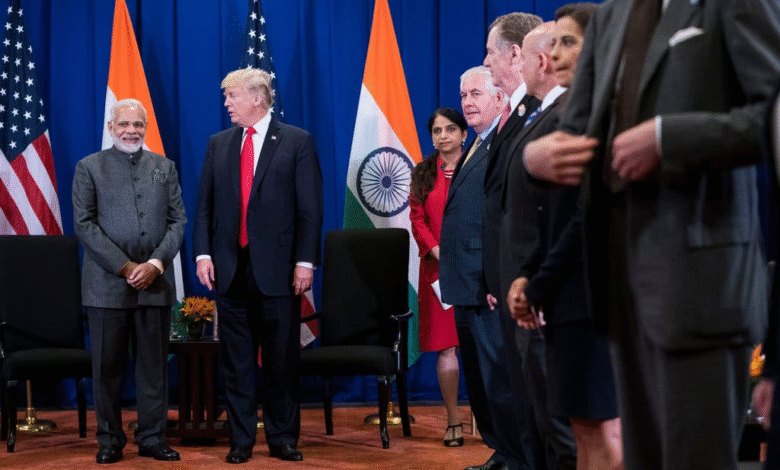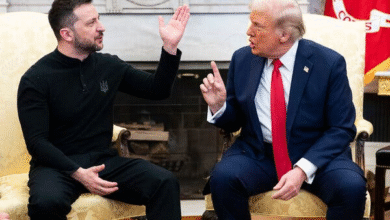US India Trade Tensions: Delegation Visit Called Off

The recent US India trade tensions have put a significant strain on the historically robust bilateral relationship between the two countries. As the U.S. delegation’s visit to India was reportedly called off amidst these escalating trade disputes, it highlights the growing friction in US India relations. Key issues stem from the Trump administration’s implementation of steep tariffs, including a hefty 25% surcharge on a variety of Indian exports, which has left India feeling cornered in these trade talks. With discussions currently on hold and no new schedule in sight, concerns continue to mount about the economic impacts of US tariffs on India. As both nations navigate this complex landscape, the outcome of their negotiations will be pivotal for their trade future and global economic dynamics.
Recent developments underscore the rising friction in trade dynamics between the United States and India, marking a significant turning point in their economic partnership. The cancellation of a planned visit by American trade representatives to India reflects deeper issues surrounding trade relations. India is grappling with increased levies under the current administration, which has imposed heavy tariffs targeting its exports while sparking dissatisfaction. Amidst this backdrop, the ongoing discussions regarding trade agreements have become more critical than ever, as both countries seek to contend with the implications of protectionist measures. As they attempt to mend fences and revive productive dialogue, the future of their trade interactions remains uncertain, crucially affecting both economies.
Current State of US-India Trade Relations
The trade relations between the United States and India have recently reached a critical juncture, marked by rising tensions and uncertainty. The U.S. delegation’s planned visit to India has been called off, which is seen as a significant setback in the ongoing trade talks. Both countries have historically maintained a robust economic partnership, yet recent developments, particularly the imposition of hefty tariffs by the U.S. on Indian exports, have strained this relationship. Reports suggest that amidst these tensions, both sides are still in communication as they navigate these complex issues.
Key factors influencing the state of US-India relations include President Trump’s aggressive tariff policies, which have placed a substantial burden on India’s export economy. Notably, the Trump administration’s imposition of a 25% tariff affects various sectors, causing Indian businesses to rethink their strategies within a competitive global market. Additionally, accusations of India being unfairly targeted due to its trade relationships with nations like Russia contribute to the ongoing discord, as the Indian government defends its trade choices and advocates for more balanced negotiations.
Impact of Trump Tariffs on Indian Exports
The introduction of Trump’s cumulative 50% tariff rate significantly alters the landscape of Indian exports to the U.S. The blanket tariff not only complicates immediate trade negotiations but also instills a sense of uncertainty among Indian exporters. Sectors such as textiles, pharmaceuticals, and engineering goods have felt the pinch, as costs rise and demand fluctuates. The additional duties set to take effect on August 27 only compound these challenges, which may lead to a decrease in exports valued at around $86.51 billion, a critical percentage of India’s overall export activity.
Moreover, this tariff imposition has broader implications on US-India relations, pushing India to reassess its trading strategies and seek alternative markets. The foreign ministry of India has articulated its concerns regarding the perceived unfair targeting, emphasizing that other nations engaging with Russia do not face similar scrutiny. This dynamic prompts India to explore diversification of its trade partnerships, potentially shifting towards regions that offer more favorable trade conditions, hence reconfiguring the existing trade landscape.
Future of Trade Talks Between US and India
The future of trade talks between the US and India remain uncertain, particularly with the recent cancellation of the U.S. delegation’s visit to New Delhi. While officials from both nations continue to stay in touch, no concrete plans have been established for rescheduled discussions. Stakeholders on both sides are anxiously waiting for a breakthrough that could ease tensions and restore a cooperative spirit in trade relations. The existing climate of uncertainty hinders long-term planning and investment strategies for businesses engaged in trade across these borders.
Analysts suggest that for successful negotiations to occur, a willingness to compromise is vital from both parties. The U.S. may need to reconsider its stringent tariffs, while India could present a more conducive framework for resolving disputes over its sourcing strategies. Consequently, the international response to these negotiations, inclusive of reactions from trade allies and competitors, will also play a crucial role in shaping the path forward. Enhanced dialogue is key to alleviating existing pressures caused by tariffs, with the potential to unlock new avenues of collaboration and trade growth.
India’s Response to US Tariff Policies
In light of the recently imposed tariffs by the U.S., India’s response has been marked by strong statements from officials who express a deep concern over perceived discriminatory trade practices. The Indian government has argued that these tariffs jeopardize its economic interests, particularly in sectors where it has a competitive edge. Moreover, through public statements, India aims to clarify that its trade relations with countries like Russia should not be a point of contention in its dealings with the U.S. Such an assertive positioning suggests a willingness to protect its economic sovereignty against unilateral actions.
Furthermore, India has been actively exploring other international trade partnerships to counterbalance the impact of U.S. tariffs. By enhancing its commercial ties with countries in Southeast Asia, Europe, and beyond, India seeks to mitigate dependence on the U.S. market. The ongoing dialogue highlights India’s strategy to cultivate a multi-faceted trade approach, addressing systemic issues while advocating for a fairer trade environment that could benefit both economies in the long run.
Consequences of Trade Tensions on Bilateral Relations
The escalating trade tensions between the U.S. and India carry significant consequences for their bilateral relations, with potential spillover effects in areas beyond trade. As both nations grapple with tariffs and trade barriers, the ramifications can extend to security cooperation, diplomatic engagement, and even cultural exchanges. The U.S. and India share mutual interests in several global issues, including counterterrorism and climate change, which could become more challenging if trade disagreements persist unduly.
Moreover, the economic interdependence that has defined US-India relations for years could gradually weaken if tariffs continue to strain these ties. This situation may lead to less collaboration in strategic sectors, such as technology and defense, which could place both nations at a disadvantage in the rapidly evolving global landscape. Thus, both parties have a vested interest in resolving trade tensions to restore their partnership to a more mutually beneficial and harmonious state.
The Role of Communication in US-India Trade Negotiations
Amidst rising tensions, the importance of continuous communication between U.S. and Indian officials cannot be overstated. Open channels for dialogue are essential for addressing misunderstandings and finding common ground to advance trade negotiations. Both nations must work towards re-establishing trust through proactive engagement, where officials from trade departments can explore solutions to tariff conflicts and other trade-related issues. The recent suspension of talks serves as a stark reminder of how quickly progress can stall without consistent interaction.
Effective communication strategies can lead to a more fruitful environment for negotiation, allowing both countries to express their concerns transparently. By fostering an atmosphere of collaboration, trade representatives can identify mutually agreeable terms that respect both national interests. The U.S. and India must leverage their diplomatic relations to ensure that trade remains a priority, ultimately working towards creating a stable and prosperous economic partnership that benefits both parties.
Exploring Alternative Trade Agreements for India
In the backdrop of rising tariffs from the U.S., India is increasingly focusing on exploring alternative trade agreements with other nations. These strategic initiatives may provide India with the opportunity to diversify its trade portfolio and lessen its reliance on the U.S. market. The pursuit of free trade agreements (FTAs) with countries in Asia, Europe, and Latin America can enhance India’s trade resilience and open new markets for its exports, thereby offsetting the impact of U.S. tariffs.
Consequently, India’s government has been proactive in negotiating favorable terms with potential partners, aiming to create a network of trade relationships that could insulate the economy from adverse effects of unilateral trade measures. Efforts to foster regional cooperation through platforms like the Regional Comprehensive Economic Partnership (RCEP) can play a pivotal role in this strategy, ensuring that India remains an active participant in global trade, regardless of the evolving dynamics with the U.S.
Long-term Implications of Current Trade Disputes
The current trade disputes between the U.S. and India could have lasting implications for both nations if resolutions are not reached promptly. The economic effects of high tariffs can lead to extended downturns in specific sectors, ultimately stifling the growth prospects for businesses reliant on trade. Concerns over retaliatory measures may also hinder companies’ willingness to invest in cross-border operations, stalling potential collaborations that could have been beneficial for both economies.
Furthermore, the longer these disputes persist, the more vulnerable Indian exporters may become in the global market. As competition intensifies from other countries seeking to capitalize on favorable trade terms, India risks falling behind if it does not adapt to the swiftly changing trade landscape. Thus, prompt and constructive engagement is essential to navigate these challenges, ultimately forging a path toward healthier economic relations.
Leveraging Technology in Trade Relations
The integration of technology into trade practices emerges as a potential avenue for improving US-India relations amid escalating tensions. By embracing digital solutions, both countries can streamline trading processes, improve compliance, and facilitate smoother logistics that could mitigate delays resulting from tariff disputes. Investments in trade technology can enhance transparency and efficiency, potentially making trade negotiations more attractive when both parties feel more secure in their transactional environments.
Additionally, the tech sector could act as a catalyst for cooperation. By prioritizing technology partnerships, the U.S. and India can exchange innovations that not only bolster their individual economies but also fortify their bilateral trade relations. Emphasis on joint projects in areas like artificial intelligence, blockchain, and data analytics can foster a positive narrative of collaboration, serving as a foundation for rebuilding trust in trade negotiations.
Frequently Asked Questions
What are the current issues in US India trade tensions?
The current US India trade tensions stem from a combination of tariff implementations and ongoing trade disputes. Recently, U.S. President Trump imposed a 25% tariff on Indian exports, which, coupled with additional penalties for India’s purchase of Russian oil, has soured relations. While both nations remain in contact, trade talks have been postponed, indicating a cooling of what has traditionally been robust US India relations.
How do Trump’s tariffs affect India exports to the US?
Trump’s tariffs significantly impact India exports to the U.S. with a cumulative tariff rate of 50%, one of the highest on U.S. trading partners. This heavy taxation on a range of goods affects India’s economic performance, as the U.S. remains a key market, accounting for nearly 20% of India’s overall exports.
Are there any recent developments in US India trade relations?
Yes, recent developments indicate that a scheduled visit by U.S. trade representatives to India was called off amidst growing trade tensions. The cancellation highlights the difficulty in moving forward with trade talks, particularly after the imposition of increased tariffs by the U.S. on Indian exports.
What does India think about the US tariffs on its products?
India has publicly expressed discontent towards the U.S. tariffs, viewing them as unfair targeting in the current geopolitical climate. Indian officials criticized the U.S. for engaging in trade with Russia while imposing punitive tariffs on India, reflecting a broader concern about the balance of trade practices.
What is the significance of US India trade tensions on global trade?
The US India trade tensions are significant as they could set a precedent for future trade negotiations globally. The heightened tariffs and stalled talks may lead to shifts in international partnerships and influence other nations in their trade strategies, affecting the dynamics of global trade.
How are trade talks between the US and India progressing amid tensions?
Trade talks between the U.S. and India are currently stalled due to unresolved issues, primarily stemming from Trump’s tariffs on Indian goods. Although both countries maintain communication, a new schedule for discussions has not yet been established, reflecting the challenges in restoring favorable trade relations.
What are the potential outcomes of the ongoing US India trade tensions?
The potential outcomes of the ongoing US India trade tensions include the possibility of further escalations in tariffs, which could lead to a decrease in trade volume between the two nations. Conversely, continued dialogue could pave the way for negotiations that may mitigate these tensions if resolved amicably.
| Key Points | Details |
|---|---|
| U.S.-India Trade Relations | The U.S. delegation’s visit to India has been called off due to escalating trade tensions. |
| Communication Status | Both countries are in contact, but a new schedule for talks has not been set. |
| Tariff Rates | Trump’s cumulative 50% tariff rate on Indian goods is among the highest imposed on any U.S. trading partner. |
| Specific Tariffs | A 25% tariff on Indian exports along with additional penalties for purchasing Russian crude has been enacted. |
| Rescheduled Visit | The visit by U.S. trade representatives was initially set for late August but is postponed for rescheduling. |
| Impact of Tariffs | India’s exports to the U.S., its top partner, accounted for nearly 20% of total exports for fiscal 2025. |
Summary
US India trade tensions have reached a critical point with the cancellation of a U.S. delegation’s visit to India amid ongoing disputes over trade policies. This situation underlines the complex relationship between the two nations, which is heavily influenced by tariff rates and compliance with international agreements. As both parties continue to communicate, the prospect of future negotiations remains uncertain, with significant implications for both their economies.




